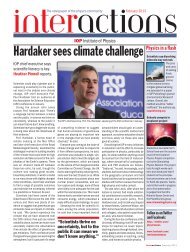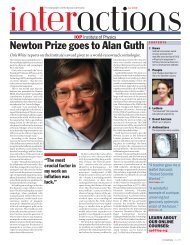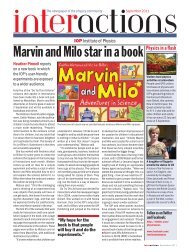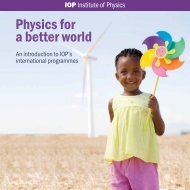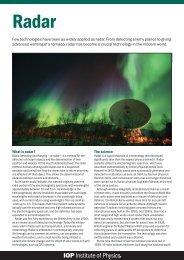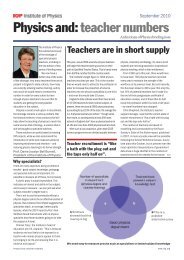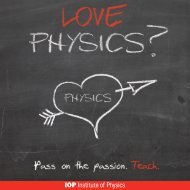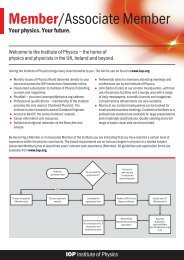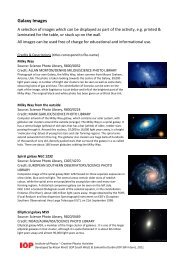Girls in the Physics Classroom: A Teachers' Guide - Institute of Physics
Girls in the Physics Classroom: A Teachers' Guide - Institute of Physics
Girls in the Physics Classroom: A Teachers' Guide - Institute of Physics
Create successful ePaper yourself
Turn your PDF publications into a flip-book with our unique Google optimized e-Paper software.
3: Lessons from videos<br />
his approaches to camera and an adviser from <strong>the</strong> <strong>Institute</strong><br />
<strong>of</strong> <strong>Physics</strong> comments on <strong>the</strong> success <strong>of</strong> <strong>the</strong> lesson. Barry<br />
starts by ask<strong>in</strong>g <strong>the</strong> whole class <strong>the</strong> “How did you get to<br />
school today?” question. He <strong>the</strong>n conducts a lesson <strong>in</strong><br />
which he is rated by an unseen commentator on his application<br />
<strong>of</strong> <strong>the</strong> five fab physics formulae.<br />
Step two <strong>in</strong> <strong>the</strong> lesson is <strong>the</strong> question “What happens<br />
when a car driver sees <strong>the</strong> brake lights come on <strong>in</strong> <strong>the</strong> car <strong>in</strong><br />
front?” Barry asks groups (which he has arranged as allboys<br />
and all-girls) to discuss <strong>the</strong> question and <strong>the</strong>n report<br />
back. The concepts <strong>of</strong> th<strong>in</strong>k<strong>in</strong>g distance and brak<strong>in</strong>g distance<br />
emerge from <strong>the</strong> exercise. The former is illustrated<br />
with a reaction-time game <strong>in</strong> which selected students report<br />
back to <strong>the</strong> class on <strong>the</strong> <strong>in</strong>teractive whiteboard. Dur<strong>in</strong>g <strong>the</strong><br />
discussion <strong>of</strong> brak<strong>in</strong>g distance, Barry is shown to be open<br />
to students’ ideas. This time <strong>the</strong> ideas are written on <strong>in</strong>dividual<br />
whiteboards so that <strong>the</strong> teacher can check <strong>the</strong><br />
response <strong>of</strong> <strong>the</strong> whole class.<br />
The class discussion <strong>of</strong> factors that might affect brak<strong>in</strong>g<br />
distance leads <strong>in</strong>to a session <strong>of</strong> group practical work. Barry<br />
enjoys <strong>the</strong> moment when <strong>the</strong> students realise that he has<br />
anticipated where <strong>the</strong>ir discussion would lead – he has all<br />
<strong>of</strong> <strong>the</strong> equipment that <strong>the</strong>y need. He expla<strong>in</strong>s his reasons for<br />
s<strong>in</strong>gle-sex groups for this work. The lesson comes to an<br />
effective end when <strong>the</strong> conclusions <strong>of</strong> <strong>the</strong> class about how<br />
speed relates to stopp<strong>in</strong>g distance are found to challenge<br />
<strong>the</strong>ir <strong>in</strong>itial predictions. Barry and <strong>the</strong> adviser both express<br />
satisfaction at <strong>the</strong> outcome <strong>of</strong> this “ambitious” lesson,<br />
while Barry acknowledges that <strong>the</strong>re was some room for<br />
improvement.<br />
24 I NSTITUTE OF P HYSICS R EPORT G IRLS IN THE P HYSICS C LASSROOM: A T EACHERS’ GUIDE FOR A CTION D ECEMBER 2006




